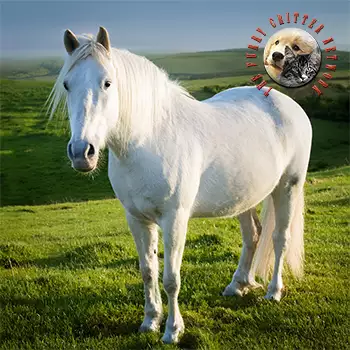General Description
Connemaras are the product of their original environment, the rugged mountain coast of West Ireland. Sure-footed, hardy and agile, they possess powers of great stamina, staying power and adaptability. They are renowned for their versatility and their gentle, tractable, sensible and willing dispositions.
Type and Conformation: Connemaras in North America range from 13 to over 15 hands. Their colors are gray, bay, brown, and dun, with some roans, an occasional black, chestnut, or palomino. Piebalds and skewbalds are not acceptable for registration.
Head: Kind eye, head well shaped and balanced in proportion to the rest of the body, neck of good length and definition, meeting the shoulder smoothly.
Shoulders: Laid-back with good slope.
Back: Strong and muscular; some length of back is normal in Connemaras, especially in mares.
Hindquarters: Well rounded and deep with good length from the point of the hip through the haunch; should balance the shoulders.
Joints: Large and well defined.
Bone: Clean, hard, flat, measuring 7- 8 inches below the knee for ponies, more for horses; forearms and gaskins long and muscular, cannons short and very dense.
Feet: Hard, strong.
The Connemara "Stands on short legs, covering a lot of ground". The cannon bone is short, dense, flat and clean, measuring 7 to 9 inches below the knee. The body is deep and compact, well-balanced with depth, substance and good heart room. The Connemara has a good sloping shoulder, length of rein, and moves freely with little knee action in surprisingly large strides for its height. On this strong, sturdy body sets a handsome pony head, with a well defined jaw and good width between large kindly eyes. Easy keepers, they do not require a rich diet to stay healthy and fit.
The most common colors are gray and dun, but there are blacks, bays, browns, chestnuts, palominos, and an occasional roan. Black points are common, but paints are not acceptable.
The Connemara is the largest of the pony breeds, ranging in height from 13 to 15 hands, with 14 to 14.2 hands as the average. Full maturity is at five years of age, sometimes older, and they can live well into their 30's.
The Connemara has a natural jumping ability, and its rectangular build lends it suitable for dressage. They often beat horses 16 hands and over with staying power, intelligence and heart. As a show jumper, working hunter, eventing, western pleasure, endurance, driving - Connemaras can do it all, and can be your best friend!
When one thinks of a pony breed children come to mind, yet the Connemara has always been a suitable mount for children AND adults. Here in the United States, the largest market for the Connemara is middle-aged women.
There are no large commercial breeding farms. Most keep only a few mares. After all, the Connemara breed was built on one good mare per farm. Foals are raised with much human contact. The Connemara is the largest of the pony breeds, ranging in height from 13 to 15 hands, with 14 to 14.2 hands as the average. Full maturity is at five years of age, sometimes older, and they can live well into their 30's.






